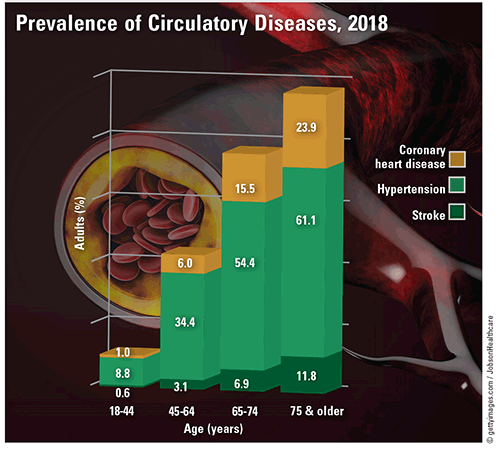US Pharm. 2020;45(2):15.
People who have cardiovascular disease (CVD) or a high CV risk (owing to hypertension, diabetes, hyperlipidemia, smoking, poor nutrition, obesity, or lack of physical activity) require early detection and management. In 2018, 30.3 million U.S. adults (12.1%) were diagnosed with CVD. In adults without disability, 12.8% were physically inactive; about 30 million adults had type 2 diabetes; and 39.6% of adults were obese. During office visits, CVD specialists wrote new prescriptions for CVD agents (antihyperlipidemics, 5% of visits; beta-adrenergic blockers, 6.1% of visits; calcium channel blockers, 6.2% of visits; ACE inhibitors, 8.1% of visits) and continued the use of more than 90% of CVD drugs previously prescribed.

Risk Factors: Roughly 47% of adults had at least one of the three key risk factors for CVD (hypertension, 78 million; high LDL cholesterol, 1 million; smoking, 34.2 million). Men were more likely than women to have at least one of these risk factors. Hypertension was the most prevalent risk factor (24.8%) among all adults, and the difference between men and women (7.4% men vs. 4.1% women) was smallest (1.1%) for hypertension and greatest (35.3%) for coronary heart disease. With increasing age, the three risk factors had similar but disproportionate rates of increase.
Prevalence by Race/Ethnicity: Of adults who experienced a stroke, non-Hispanic black patients had the highest prevalence (4%), followed by 2.7% of non-Hispanic white patients and 2.5% of Hispanic patients. Non-Hispanic black patients had the highest prevalence of hypertension (32.8%), followed by 25.1% of Hispanic patients and 24% of non-Hispanic white patients. However, the order of prevalence was different for coronary heart disease; the greatest prevalence was found in 5.8% of non-Hispanic white patients, closely followed by 5.7% of Hispanic patients and 5.4% of non-Hispanic black patients.
Diagnostics: In visits to primary care providers, blood pressure was moderately high for white patients (16.6%), black patients (16.1%), and Hispanic patients (9.5%). Compared with younger patients, moderately high blood pressure was more common in those aged 45 years and older, and 42% more women than men had moderately high blood pressure. CVD specialists, who accounted for 3.1% of all visits to healthcare specialists, spent more than 20 minutes with each patient. Just over 9.1% of these visits (involving 10% more men than women) were for a lipid profile. From 2005 to 2009, the percentage of adults screened for high cholesterol increased from 72.7% to 76.0%. According to the Agency for Healthcare Research and Quality, diagnostic tests for the circulatory system accounted for 20% of costs for all major diagnostic categories in 2009.
To comment on this article, contact rdavidson@uspharmacist.com.





